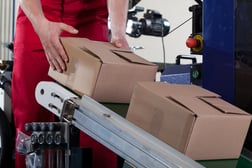
The manufacturing industry is having its share of difficulties attracting skilled employees. As a result, manufacturers struggle to optimize productivity in their warehouses. Job seekers may avoid applying for available positions, thinking that warehouse work is dark, dirty, and offers no opportunities for advancement. Manufacturing warehouse automation improves the working environment for employees while improving productivity for the company. It’s a win-win situation.
ERP System is Crucial Part of Automation Plan
ERP software that incorporates a cutting-edge warehouse management system (WMS) can help you optimize processes, streamline workflows and decrease errors. The benefits include happy customers (due to on-time deliveries); increased employee satisfaction (because automated processes are less labor-intensive); and an overall boost to business profitability (less time spent on manual tasks).
Four Ways to Implement Manufacturing Warehouse Automation
Here are four simple manufacturing warehouse tips to help you run your warehouse more efficiently:
1. Analyze and Reorganize Warehouse Space
Effective warehouse organization ensures pickers spend less time searching for items and make fewer mistakes. Here are some ideas to increase warehouse space efficiency:
Label aisles, rows and bins with floor or overhead placards. This enables employees to identify the correct location quickly and easily. It sounds simple, but using alphanumeric logic can help you optimize picking strategies without having to implement a more complex warehouse mapping solution.
Separate raw materials and finished goods. When manufacturers run out of warehouse space, it’s easy to stash inventory wherever there is room. But misplaced inventory can slow or even halt production and delay shipments to customers.
Use space-saving containers or shelving. For example, by stacking containers higher you can make use of vertical space, and mobile shelving units can be useful for seasonal products.
Establish a layout based on order picking. Using two logical, simple rules can increase efficiency:
- Fast-moving inventory should be easily accessible and quickly replenished; and
- Products frequently purchased together should be located near each other in your warehouse.
2. Improve Speed and Accuracy When Picking Orders
Order picking is one of the most labor-intensive and expensive activities in the warehouse and by harnessing the information provided by your ERP you can increase its speed and accuracy. Here are three techniques to improve order picking operations.
- Pick by bin location. When printing your packing slips, simply sort by bin location. Sales orders will appear in a logical flow for picking.
- Group multiple orders. By consolidating multiple orders into a single pick list for your operators, you reduce travel time and eliminate errors.
- Take advantage of suggested picks. With an effective WMS, even manufacturers who don’t allocate bins or lots ahead of time can access suggested picks. This can be particularly helpful for, say, food manufacturers who are tightly managing inventory based on FIFA (First in First Out) or FEFO (First Expire First Out) practices.
3. Update Barcode Scanner Hardware and Software
Barcode scanners are a crucial component of automating data collection, saving time and reducing errors in your warehouse. Yet many manufacturers regard replacing old systems as an unnecessary expense.
Newer barcode scanning equipment has greater scanning distance and can load products lots much quicker. It may seem like a minor issue, but if a picker is picking 20 to 50 lines a day, multiplied by 20 pickers across two shifts, that wasted time starts to add up. At the end of the day, investing in updated equipment enables you to take advantage of time-saving features and makes it easier for the operators to do their job.
4. Implement Pallet Tracking or Master License Plating
Particularly in a low volume, high SKU warehouse, picking can feel like a scavenger hunt, because operators are not picking the same items over and over and items are often stored in random locations. Pallet tracking gives you a way to group and manage inventory items.
By attaching a barcode label, RFID tag and/or IoT sensors to your pallets, your ERP software can provide real-time information about the pallet’s location (what items are on the pallet, where it is now, where it was earlier and how many times and where it was moved), as well as its status (whether it is in inventory or has been issued to a job, etc.).
Benefits include:
- Pickers spend less time searching for pallets
- They can manage or move items by common container or pallet with one scan
- They can stage items for sales orders or jobs
- You can set up your system to match how your operators physically work
- You know immediately when a pallet is removed (a powerful tool for preventing theft)
PositiveVision is the Right Partner for Manufacturing Warehouse Automation
PositiveVision (PVI) has been serving the needs of manufacturing customers in Chicago for over three decades. PVI's experts will gladly guide you through your ERP decision-making to help you make an informed choice. Contact us today to speak to one of our product experts about a custom solution for your business. When you reach out, ask about our software training services for your team.
To learn more about how you can modernize and improve your warehouse operations, check out this webinar.



 © 2019 PositiveVision • 219 E. Thorndale Ave. Roselle, IL 60172
© 2019 PositiveVision • 219 E. Thorndale Ave. Roselle, IL 60172